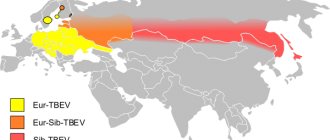Category: Children Published 02/06/2019 · Comments: · Reading time: 5 min · Views: Post Views: 633
Chickenpox encephalitis in children is a rare but dangerous complication of chickenpox, which occurs with reduced immunity. The second name is inflammation of the brain.
Encephalitis due to chickenpox occurs in 1 case out of 10,000. As a rule, brain damage that occurs with chickenpox is typical for children with reduced immunity:
- primary immunodeficiency;
- secondary – as a result of chemotherapy.
The absence of an immunodeficiency state does not exclude the development of complications. Therefore, all parents need to know the first signs of developing chickenpox encephalitis.
Classification
The clinical picture of chickenpox cerebral inflammation may precede rashes on the body of children, accompany the rash, or appear at the stage of crust formation. As you know, pimples on the body appear between 3 and 10 days from the moment of infection. In this regard, chickenpox encephalitis is classified as follows:
- Prevaricella - occurs before the appearance of vesicles.
- Early – accompanies the period of rashes.
- Late - appears at the stage of crust formation.
Post-vaccination encephalitis
Click to enlarge
Vaccination against chickenpox in Russia is included in the National Calendar as recommended. That is, parents themselves decide whether to do it or not. The age of children for primary vaccination is 2 years. In Europe, it is carried out when the baby reaches 1 year of age simultaneously with immunization against measles, rubella and mumps.
Vaccine administration involves the formation of specific immunity to a specific disease. The corresponding antibodies are produced in response to the introduced antigens. When the immune system malfunctions, antibodies are released to its own tissues, for example, to brain cells. Post-vaccination encephalitis after chickenpox vaccination is also an autoimmune reaction. As a result, damage to cerebral vessels, perivascular tissue, and white matter of the brain occurs. Demyelination occurs—the destruction of the myelin sheath of nerve cells, which leads to a disruption in the transmission of nerve impulses.
The clinical picture usually develops 7-10 days after vaccination. Body temperature rises, consciousness is depressed, vomiting and headache appear. Meningeal symptoms are possible when the meninges are involved in the process. Landry's paralysis is considered a dangerous post-vaccination complication. Along with inflammation of the brain, in this case, chickenpox myelitis (inflammation of the substance of the spinal cord) and polyneuropathy develop. The first signs appear in the form of paralysis of the lower extremities, later dysfunction of the upper extremities and bulbar palsy are added, which leads to death. This is the worst case scenario. More often, the pathological process occurs with adequate treatment with a favorable outcome.
Manifestations of the disease
Chickenpox encephalitis, which occurs before the appearance of vesicles, is called pre-varicella encephalitis. The one that develops during the rash is designated as early, and the late one (or post-varicella) is called the one that developed at the stage of crust appearance. Doctors believe that the first two types are the result of direct damage to the brain by the virus. Late encephalitis occurs in response to an inflammatory process and is infectious and allergic in nature. This type is considered the most common, and it also has a relatively favorable prognosis.
Its main symptoms:
- severe headache with vomiting, dizziness;
- weakness and lethargy;
- a sharp increase in temperature;
- paresis (partial paralysis);
- facial asymmetry;
- impaired coordination of movements, body statics, nystagmus (tremor of the eyeballs with high frequency), hand tremor as a consequence of damage to the cerebellum;
- disappearance of facial expressions;
- involuntary excessive movements (hyperkinetic syndrome).
Late chickenpox encephalitis, as a rule, passes without loss of consciousness and convulsions, since the cerebral cortex is not affected in its case. Symptoms last for about 7–10 days. The first to go away are headaches, vomiting, fever, and then neurological manifestations. Dizziness and coordination problems may occur for several months.
In some cases, cerebellar abnormalities may be the only sign of the disease. Researchers even suggest that acute cerebellar ataxia is a sign of chickenpox encephalitis without a rash.
Symptoms
Signs of developing chickenpox encephalitis consist of a syndrome of cerebral disorders and focal symptoms. As a rule, chickenpox encephalitis in children begins with general cerebral disorders:
Click to enlarge
- headache, dizziness;
- nausea and vomiting;
- weakness, loss of consciousness;
- hallucinations, delusions;
- repeated increase in temperature;
- stupor, coma.
In the future, a picture of focal brain lesions is added, which will be individual for each patient:
- the appearance of nystagmus;
- double vision or squint;
- facial asymmetry;
- tongue deviation to the side;
- difficulty swallowing, hoarseness;
- pain in the face;
- paresis and paralysis;
- the appearance of involuntary movements of the limbs – hyperkinetic syndrome;
- unsteadiness when walking;
- the appearance of seizures;
- tremor of the limbs and whole body.
What is a complication of the disease?
It is necessary to distinguish between complications of the disease, severe course of the disease and its atypical forms.
According to the definition, a complication of a disease is a pathological process added to the main disease, aggravating the typical course of the disease and caused not by its cause, but by additional changes that occurred in the body during the course of the disease. Complications do not always develop, but can be significantly more severe than the underlying disease[2].
Chickenpox and its complications. Photo - Lori's photo bank
Among the complications of chickenpox, the most common are purulent skin lesions - boils, abscesses and others. Viral pneumonia, which is the most common complication in adults, is severe, and the most dangerous complication of this infection from the nervous system is damage to the brain - encephalitis - or its membranes - meningitis[3].
Treatment of brain inflammation
Treatment of chickenpox encephalitis in a child is carried out in a hospital setting, often in intensive care wards. Treatment consists of:
- The use of antiviral agents. In stationary conditions for chickenpox inflammation, intravenous drip infusions of Acyclovir are performed.
- Anti-edematous therapy. Use of potassium-containing diuretics, mannitol. Additional administration of Diacarb is possible.
- The use of glucocorticosteroids as anti-inflammatory and anti-edematous therapy.
- Relief of convulsive seizures by taking antiepileptic drugs.
Causes
Chickenpox encephalitis often develops in children after one year of age. Chickenpox in the first year of a baby’s life is easily tolerated and can be quickly treated, so complications do not arise, especially in infants. This is explained by the constant feeding of the baby’s immunity with maternal antibodies that are present in breast milk. The illness is more difficult to bear if the nursing mother has not had chickenpox, but the chances of chickenpox encephalitis in such a child are still small.
But against the background of severely reduced immunity, from days 3 to 7, the baby may develop acute symptoms in the form of high fever, profuse rash all over the body, gushing vomiting, convulsions, paresis, distortion of the facial muscles, delusional syndrome, and disorientation. In the subacute course, the symptoms are less pronounced, but the disease is revealed by hand tremors, unsteady gait, weakness, and incoordination.
Chickenpox is easily tolerated by babies up to one year of age.
Chickenpox encephalitis often develops in children after one year of age. Chickenpox in the first year of a baby’s life is easily tolerated and can be quickly treated, so complications do not arise, especially in infants. This is explained by the constant feeding of the baby’s immunity with maternal antibodies that are present in breast milk. The illness is more difficult to bear if the nursing mother has not had chickenpox, but the chances of chickenpox encephalitis in such a child are still small.
But against the background of severely reduced immunity, from days 3 to 7, the baby may develop acute symptoms in the form of high fever, profuse rash all over the body, gushing vomiting, convulsions, paresis, distortion of the facial muscles, delusional syndrome, and disorientation. In the subacute course, the symptoms are less pronounced, but the disease is revealed by hand tremors, unsteady gait, weakness, and incoordination.
Chickenpox encephalitis is considered a serious complication of chickenpox. Children tolerate this disease much easier than adults. It is necessary to consider specifically what chickenpox-type encephalitis is, the reasons for its development, symptoms, and the main methods of treatment and prevention.
Complications and rehabilitation
The disease rarely goes away without a trace.
Chickenpox encephalitis in children has consequences in the form of residual focal disorders, for example, facial asymmetry, paresis, strabismus. Often the child later experiences headaches and dizziness. With the development of epileptic seizures, cases of persistence of the episyndrome into adulthood are observed. If a child has had chickenpox encephalitis, then the baby may be hospitalized for the second time in a hospital after a couple of months for the purpose of rehabilitation measures:
- vitamin therapy - injections of B vitamins;
- use of nootropic drugs;
- antiepileptic therapy, betahistine drugs;
- therapeutic exercises, massage;
- physiotherapy;
- acupuncture (for older children).
Rehabilitation is carried out not only within the walls of the department. An important condition for the restoration of lost functions after chickenpox inflammation of the brain is the daily work of parents to restore the child’s health. These include daily long walks, physical therapy and massage. It is important to set the baby up correctly and convince him that his health will definitely be restored. After recovery, children are subject to clinical observation by a neurologist for two years.
Encephalitis as a dangerous consequence of chickenpox
Chickenpox is considered to be a relatively safe childhood disease, but we must not forget that it can also cause serious complications, especially in children with low immunity.
One of them is chickenpox encephalitis: a rather rare case, but you need to know about it.
About illness in children and adults
Chickenpox encephalitis is an inflammatory process that occurs in the brain. Its cause is the virus that causes chickenpox. It belongs to the group of herpes viruses and can affect the nervous system.
Most of the virus is found 3-4 days after infection. Already on the 5th day, its quantity drops sharply. On the 8th day, the virus is practically no longer detectable in chickenpox blisters. At this time, the patient becomes practically safe for others.
The risk of contracting chickenpox from it is minimized.
The chickenpox virus is only dangerous to humans; animals and birds are not susceptible to it.
The outcome is most favorable for late chickenpox encephalitis in children. In this case, the brain is not affected, there are no such dangerous manifestations as convulsions or coma. After 7-10 days, with proper treatment, the patient’s condition improves. The symptoms go away.
Symptoms
Although chickenpox is a very common disease, it rarely leads to encephalitis. If it develops, the sick child develops multiple painful symptoms.
The most serious symptoms of chickenpox itself (high fever, rash) appear between 3 and 7 days after infection. Convulsions and vomiting may occur. These are very alarming manifestations. They say that the acute form of chickenpox develops uncharacteristically and complications begin. This happens if the parents did not undertake timely treatment or inadequately assessed the danger of the disease.
Complications develop several days after the first rash appears. Sometimes chickenpox encephalitis begins before its immediate appearance on the child’s skin. The disease begins with symptoms characteristic of chickenpox:
- sore and sore throat;
- cough appears;
- the child sneezes.
This condition is distinguished from a common cold by a raised rash that begins to appear on the body and quickly takes on its shape.
It is important to know
With chickenpox encephalitis, the rash will not be the same as with chickenpox. Pustules form over large areas. It is important that parents monitor each new symptom, as it can occur in a hidden form.
Key symptoms of chickenpox encephalitis:
- disturbance of appetite, sleep;
- apathy;
- weakness;
- convulsions;
- dizziness, loss of coordination;
- vomit;
- asymmetry on the face.
Any of the listed symptoms is a reason to immediately show the child to the doctor. If this condition is ignored, cerebral edema, severe convulsions, and coma may develop. As intracranial pressure increases, the child may lose consciousness and even fall into a coma.
To make a correct diagnosis, the doctor performs laboratory diagnostics. A CT or MRI may be prescribed. An analysis of the spinal cord fluid is required. This is the only way to accurately detect the presence of chickenpox. MRI is performed to detect epileptic syndrome.
A blood test is also prescribed. If the number of lymphocytes and protein increases, the presence of infection can be suspected. The doctor will definitely ask whether the child has previously had chickenpox or whether he has had contact with an infected person.
Encephalitis due to chickenpox
Chickenpox encephalitis during the hero of the occasion - chickenpox is rare. It is tolerated more easily by children than by adults. But the condition will still be serious.
In adults, chickenpox itself is severe. It may be accompanied by neuritis. Encephalitis, as a complication of chickenpox, occurs much more often in adults than in young patients.
Under no circumstances should you hope that chickenpox, or especially encephalitis, will go away on their own! If the flow is prolonged, there is a real threat to life. At the first symptoms you need to go to the doctor.
With encephalitis, the immune system cannot cope with the invading pathogen. Immune reactions are disrupted. In the early stages of the disease, many specific antibodies are present in the blood. In this case, the infection still generalizes, encephalitis develops, and an infectious-allergic process occurs.
Methods of effective treatment
It is very important that parents respond to the manifestations of the disease in a timely manner.
Treatment is only inpatient.
The disease can be detected using MRI and CT.
The main drug for treatment is Acyclovir. This is an effective antiviral agent. In this case, it is administered intravenously.
Main methods of treatment:
- Diuresis with potassium supplements. They remove toxins well and relieve brain swelling.
- Relief of seizures.
- Relieving inflammation with corticosteroids.
- Improving blood circulation in the brain (Cortexin, Glycine, Clexane, Aspirin can be prescribed for this).
Any drug for chickenpox is prescribed only by a doctor. It is important to choose a safe dosage and correctly combine drugs. It is necessary to monitor the child’s condition, as an allergy to the drug may develop.
The course of treatment takes about two weeks. Then the symptoms gradually disappear.
When the symptoms pass, the patient feels relief, he is sure to be prescribed vitamins (group B). You need to wait a couple of weeks for the immune system to recover after an attacking infection. Vitamins will also help restore brain activity. We must not forget that encephalitis is a neurological disease. You will need to consult a neurologist or therapist.
Despite the fact that after recovery the symptoms completely disappear, the patient will be observed by a neurologist and pediatrician for another 2 years. Only in this case can the consequences of the disease be completely overcome. At the same time, a set of studies is regularly carried out.
Consequences of the disease
If you ignore the pathological condition and do not take action, dangerous consequences are possible:
- The sick person may experience a severe headache. It intensifies when a person moves his neck.
- A sick baby may lose consciousness for no apparent reason.
- The infection can spread to the spinal cord. In this case, defecation, urination, muscle tone are impaired, and skin sensitivity increases. These are clear symptoms that brain activity is impaired.
- Coma may develop.
- Epileptic seizures may occur. They are very dangerous and can even be fatal.
- Even death is possible (10% of cases).
Don’t be scared in advance and expect the most severe complications. Some of them are relatively safe.
For example, with late encephalitis, dizziness can be observed for quite a long time - one and a half to two months. This is a standard symptom. It only requires the attention of a specialist and correction of the condition.
Don't forget about prevention
The most effective prevention of chickenpox is quarantine. Contact with the sick person should be avoided. If suddenly someone in the family gets sick, he should be immediately protected from children and adults. If you do this immediately after the first rash appears, the risk of infection will be minimized. Quarantine must be observed until the 9th day from the moment the first rash appears.
If you find out that someone in kindergarten or school has chickenpox, it is better to leave the child at home.
Also, some doctors advise administering immunoglobulin intramuscularly to strengthen the immune system. This is a controversial method. Not everyone finds it effective.
If you suspect the development of smallpox, you should contact an infectious disease specialist or pediatrician.
Doctors advise the following:
It is very important that parents constantly monitor their child from the first days of the disease. If dizziness, vomiting, lack of coordination, or fever does not go away, you need to call an ambulance.
Bogdan Viktorovich, pediatrician, 48
Treatment of chickenpox encephalitis is carried out only in a hospital. From the first hours, Acyclovir must be administered intramuscularly. It will cope well with the pathogen and relieve swelling. The doctor must constantly monitor the child's condition. The treatment regimen may vary depending on how the body reacts to it.
Irina, pediatrician, 35
In no case should chickenpox be considered a harmless disease. It requires close attention and timely comprehensive treatment. Adults suffer it worst of all, but in my practice there have been many cases when children also suffered from complications. Most often, complications develop due to untimely or poor-quality treatment. You must strictly follow all doctor's instructions.
Georgy Lvovich, infectious disease specialist
Conclusion
Encephalitis is a serious and dangerous complication of chickenpox. In this case, damage to the central nervous system develops. It’s better not to let things get to this point. To avoid dangerous consequences, chickenpox must be detected promptly and treated correctly. Therapy is prescribed by a pediatrician after a comprehensive diagnosis. Remember, if treatment is not taken, irreversible changes may begin in the body!
If someone in your family has chickenpox, it is important to limit access to them. This is a highly contagious disease. The pathogen can even penetrate from a neighboring apartment.
With chickenpox, quarantine becomes the key to safety. The patient is not allowed to see peers and family members. If, after the appearance of a rash, you immediately take action and begin treatment, a positive outcome of the disease is 90% guaranteed. But there is no vaccine for encephalitis yet. To prevent it, you need to strengthen your immune system, and in case of illness, use drugs to stimulate the immune system.
We recommend other articles on the topic
Source: https://herpes.guru/vetryanka/encefalit.html
Reasons for the development of complications
The consequences of chickenpox in children occur more often due to the influence of several external or internal factors. Possible causes of complications include:
- Age over 12 years. The older the child, the higher the risk of complications.
- A severe course of the disease, in which the rash has a large number of blisters and the temperature rises to 40 degrees.
- Weakened immunity. Chickenpox is especially dangerous after vaccination, against the background of chronic diseases.
- Failure to comply with hygiene rules. This leads to a buildup of bacteria that complicates chickenpox.
Possible complications of chickenpox in children
The most common complications of chickenpox are lymphadenitis, encephalomyelitis and herpes zoster, and less commonly pneumonia and otitis media. Chickenpox can negatively affect the kidneys, joints, and heart. All the consequences of this disease, depending on the cause, are divided into two main groups:
Caused by the toxic effect of the herpes virus type 3, which causes chickenpox.
Associated with weakened immunity
Pneumonia
Bronchitis and pneumonia account for 20% of all the consequences of chickenpox. The following symptoms indicate lung damage due to chickenpox:
- bluish skin;
- dyspnea;
- dry cough, which gradually turns into wet cough with sputum;
- high temperature at 38 degrees;
- weakness and malaise;
- hemoptysis.
Pneumonia can lead to pulmonary edema and respiratory failure. Please note that this complication is caused not only by the herpes virus type 3, which causes chickenpox. In some cases, pneumonia is caused by bacteria. Determining the causative agent is important for prescribing a treatment regimen. Depending on this, the doctor prescribes antiviral or antibacterial drugs.
Encephalitis
Chickenpox causes 25–30% of all encephalitis in children. According to various sources, this pathology leads to death in 10% of cases. Encephalitis is dangerous because it is difficult to treat and affects the brain. Even after recovery, the child may still have some neurological disorders, including epilepsy and paresis. Characteristic symptoms of encephalitis:
- heat;
- severe headaches that are not relieved by painkillers;
- unsteady gait;
- disturbances of consciousness;
- tremor of the limbs;
- convulsions;
- occasional vomiting.
Treatment of encephalitis occurs only in a hospital setting. If these symptoms appear, you should not self-medicate. Attempts to reduce the temperature will not give the desired result. Treatment regimen for encephalitis:
- dehydration and fight against cerebral edema;
- desensitizing therapy;
- normalization of breathing due to oxygen therapy;
- improvement of microcirculation.
Damage to the skin and mucous membranes
Local complications occur in 45% of the total number of complications, i.e. they are the most common. The main reason is the child scratching the itchy blisters. As a result, bacteria penetrate into the wounds, which provoke purulent inflammation. Damage to the mucous membranes by herpes type 3 manifests itself in the development of stomatitis.
This is not life-threatening, but can lead to the formation of scars and scars after chickenpox. Characteristic symptoms of purulent inflammation:
- the skin around the sores begins to redden and swell;
- the liquid inside the bubbles becomes cloudy.
If the wounds heal at an early age, then practically no traces remain. The older the child, the higher the risk of scarring. Treatment includes the use of antibacterial and healing ointments. If measures are not taken in time, necrosis may develop. In boys, scars left after scratching the blisters on the head of the penis can affect their sexual life in the future.
How to minimize the risk of complications
To minimize complications from chickenpox in children, it is important to practice good hygiene. They are necessary for timely cleansing of the skin in affected areas and preventing secondary infection. Basic preventive measures:
- When treating chickenpox, use antipruritic medications to prevent scratching the wounds and introducing infections into them.
- Trim your child's nails short to prevent him from scratching the rash.
- Bath your child regularly, but replace drying the body by blotting with a towel.
- Change your underwear and bed linen more often.
- Provide dairy-vegetable nutrition with plenty of liquid.
Treatment options
Drug therapy includes taking antiviral (Acyclovir) and immunomodulatory (Interferons, Roncoleukin, Immunoglobulins) drugs. In parallel, if necessary, medications are prescribed to eliminate neurological symptoms. To eliminate convulsive syndrome and correct psychomotor agitation, Diazepam is prescribed. For infectious-toxic shock, Prednisolone and Dexamethasone are used.
In a hospital setting, if necessary, infusion therapy with sodium chloride is carried out and an oxygen mask is used. For headaches, Ketoprofen and Lornoxicam are prescribed as painkillers. Antiemetic - Metoclopramide. To lower body temperature - Paracetamol, Acetylsalicylic acid (contraindicated in children under 15 years of age). Evaluation criteria for treatment effectiveness include:
- No progression of neurological symptoms.
- No progression of cerebral syndrome.
- Stable hemodynamic parameters (pulse, blood pressure, respiration, heart rate).
Pathogenetic therapy is aimed at combating cerebral edema (Mannitol, Furosemide), improving microcirculation (Dextran), desensitization (Chloropyramine, Clemastine). Physiotherapeutic procedures are prescribed - UHF, ultrasound, Bernard diadynamic currents. During the treatment period, doctors recommend bed rest. Sanitary and hygienic measures and regular aeration (ventilation) of the premises are carried out.
Course of the disease
The appearance of signs of chickenpox encephalitis is not immediately observed. In the pre-chickenpox and early period of the disease, no signs of damage to the nervous system will be observed. At this stage of the pathology, the child’s condition will be satisfactory. At this time, the causative agent of the pathology, that is, type 3 herpes virus, is not yet strong enough to infect the nerve fibers.
The first neurological signs of encephalitis appear 2-3 days after the appearance of skin rashes. In addition, during this period there is an increase in signs of general intoxication, so manifestations of brain damage may go unnoticed, especially if they are not too intense. This is the most dangerous period of chickenpox, since in the absence of targeted treatment the patient may fall into a coma.
In the late period of chickenpox, the development of encephalitis is extremely rare. Neurological symptoms are increasing, although the period of rash continues to decline and the existing papules on the skin gradually disappear.
Diagnosis of chickenpox encephalitis
The specialist will make a preliminary diagnosis at the stage of examination and clarification of the medical history. To confirm, the doctor will prescribe the following mandatory tests:
- general blood test;
- blood test for herpes type 3 using ELISA;
- MRI or computed tomography of the brain;
- lumbar puncture followed by analysis of cerebrospinal fluid;
- electroencephalogram;
- examination of the fundus (consultation with an ophthalmologist).
When collecting anamnesis, it is important for parents to remember all possible details and talk about the vaccinations performed. This is especially true for chickenpox vaccination. It is worth keeping in mind that a similar reaction can occur to any vaccine.
Symptoms
Damage to the central nervous system leads to the appearance of characteristic symptoms of encephalitis in chickenpox. This causes an increase in disturbances of gnosis and praxis, that is, the patient loses the ability to recognize the environment, navigate the surrounding space and perform purposeful actions.
Often, already in the first days after the onset of the development of this complication, acute cerebellar ataxia occurs, expressed by the patient’s inability to coordinate movements. Cognitive abilities decrease. In addition, against the background of nerve damage, the following symptoms may appear:
- decreased muscle tone;
- speech disorders;
- migraine;
- severe vomiting;
- facial asymmetry due to damage to the facial nerve.
Encephalitis caused by the varicella zoster virus is characterized by seizures. There is a high probability of developing delirium already in the early stages of this complication. Brain disorders progress over 2-7 days. After this period, regression of neurological symptoms is observed.
Symptoms of chickenpox encephalitis
Encephalitis after chickenpox is a rare complication. It usually develops against the background of fading skin rashes, usually within 5-15 days of the disease. Characterized by:
There are cerebellar and cerebral forms. In the cerebellar form, a few days after the onset of the disease, the main, specific symptoms of chickenpox encephalitis, typical in children and adults, appear:
- Uncertainty, unsteadiness of gait.
- Ataxia, instability in the Romberg position - about 100% of cases.
- Dizziness (65% of cases), impaired motor coordination.
- Speech dysfunction (dysarthria - impaired pronunciation, quiet, slow speech) - 85% of cases.
- Nystagmus – 81% of cases.
- Loss of appetite.
In severe cases of infection, tremors of the limbs and torso are observed when trying to reproduce movement. It is difficult for the patient to stand or sit due to a sharp decrease in muscle tone. Patients become lethargic, inactive, and prefer to lie down. Sometimes the state of apathy alternates with bouts of euphoria. Facial expressions are poorly expressed.
Meningeal symptoms may appear slightly (muscle rigidity in the occipital area, positive Kernig symptoms, forced position of the head with a tendency to tilt back). Mild confusion of consciousness is observed in 18% of patients. In some cases, symptoms of encephalitis after chickenpox in children and adults include:
- Convulsive syndrome.
- Hemiparesis is paresis in one half of the body.
- Aphasia is a speech disorder.
- Psychomotor agitation.
Encephalitis with chickenpox is characterized by the reversibility of pathological processes and changes. Palpation reveals an increase in the size of the lymph nodes, mainly in the neck, groin, and back of the head. Consultations with a neurologist, otolaryngologist, and pediatrician (in childhood) are recommended.
Statistics show that the cerebellar form of the disease with characteristic symptoms (ataxia, dysarthria, impaired motor coordination) is detected in 93% of cases. The cerebral form occurs with a frequency of about 6% of cases. Neurological symptoms occur 5-7 days after the appearance of skin rashes. In 50% of cases, cerebral chickenpox encephalitis in adults and children debuts with the development of convulsive syndrome.
In half of the patients, at the initial stage, cerebellar disorders are observed, which after a day are supplemented by progressive cerebral edema with confusion and psychomotor agitation, alternating with periods of depression of mental and physical activity. For the cerebral form, an increase in temperature to 38-39°C is typical.
Changes in the structure of the brain during an MRI study are detected in 12% of cases. In the cerebellar form, during a study in the format of evoked potentials, all patients observed a process of demyelination of stem structures. In the cerebral form, damage to neurons in the cerebral hemispheres is detected. Cerebrospinal fluid analysis shows increased protein concentrations and lymphocytic pleocytosis (increased lymphocyte levels).
What provokes the reasons
The causative agent of encephalitis in this disease is considered to be Strongiloplasma varicellae. Throughout the incubation period, the amount of virus in the patient’s body increases rapidly, reaching its peak approximately 3-4 days after the appearance of skin signs of the disease.
Against the backdrop of decreased immunity during this period, an autoimmune reaction may occur. Not only the virus, but also the body’s own antibodies have a negative effect on nerve fibers. Brain damage can occur when the virus reactivates and shingles develops.
Treatment
If you notice the slightest signs of encephalitis caused by chickenpox, you should consult a doctor. The patient is prescribed:
- MRI;
- CT;
- electroencephalography;
- virological study of swabs;
- cerebrospinal fluid analysis.
A biopsy of brain tissue is performed extremely rarely. After diagnosis, the patient should be sent to a hospital to undergo comprehensive treatment. Therapy at home is not allowed due to the high risk of complications that are life-threatening to the patient.
Antiviral drugs are prescribed in the form of tablets and injections. Medicines such as Virolex and Zovirax are often used. In the acute period, corticosteroids and immunoglobulin are often introduced into the treatment regimen. Prednisolone is often used to desensitize the patient's body. To support the body during encephalitis, calcium and potassium supplements are often prescribed, including:
To eliminate the allergic reaction observed with encephalitis, antihistamines are used. Drugs belonging to this group include:
To prevent the development of cerebral edema, diuretic medications may be prescribed, including:
When treating encephalitis, vitamin complexes are often prescribed. If the patient has signs of emotional arousal, sedatives based on valerian are prescribed. In addition, the use of drugs such as Phenibut and Tazepam may be advisable. Starting from the second week, when neurological symptoms gradually decline, nootropic drugs and strengthening drugs can be used. During the entire period of the disease, the patient needs complete rest and a gentle diet (more details here).
Diagnostics
Diagnosis begins with checking existing symptoms. The doctor carefully examines the clinical picture and can make an accurate diagnosis without laboratory tests.
The patient is prescribed the following studies:
- Collection and analysis of cerebrospinal fluid (CSF). When sick, her blood pressure is elevated. In the presence of complications, an increase in lymphocyte and protein levels is detected.
- Serological analysis (search for antibodies to the virus in the patient’s blood).
- MRI and CT (computed tomography) of the brain.
- Electroencephalogram - allows you to determine the level of electrical activity in the brain. The patient exhibits brain changes characteristic of epilepsy.
- Virological analysis of nasopharyngeal lavages.
- Brain biopsy - during the study, the doctor removes cells from the brain tissue for further study.
Diagnosis of the patient’s condition is carried out on the basis of epidemiological data - cases of contact of the patient with patients with chickenpox are checked and it is found out whether the person has had chickenpox before.
The basis for making an accurate diagnosis is the presence or absence of antibodies to the varicella-zoster virus. After complete recovery, the child is regularly taken to a neurologist for another 2 years.
Consequences and complications
The outcome of the disease is impossible to predict. The prognosis is worsened by the development of acute conditions such as coma and cerebral edema. In this case, the risk of death is quite high. The course of encephalitis that occurs against the background of chickenpox may be accompanied by:
- paralysis of limbs;
- disruption of the pelvic organs;
- joint neuropathy, etc.
There is a high probability that residual effects from these disorders will persist for some time and require additional therapy.
Among other things, if the course of encephalitis is unfavorable, the patient may experience the following for 1.5-3 months:
- hyperactivity;
- decreased intellectual abilities;
- speech disorders;
- inability to concentrate;
- memory impairment.
Some patients subsequently experience emotional lability. Increased aggressiveness or tearfulness is possible. All symptomatic manifestations disappear with proper drug treatment within six months. In severe cases, it takes several years to correct residual effects. Despite the fact that the prognosis of encephalitis is favorable, after the disappearance of all manifestations there remains a risk of developing epilepsy.
The concept of pathology
The pathogenesis (mechanism of origin and development) of chickenpox encephalitis is characterized by an abrupt onset and a short course. The disease does not appear in infants under 1 year of age - they are protected by maternal antibodies transmitted through milk.
The causative agent of chickenpox, previously settled in the ganglia (nerve plexuses), is activated when the immune system is impaired or when the child is severely exhausted. A weakened body cannot fight infection, so the disease must be treated at the initial stage. Activation of varicella-zoster in adults usually leads to the development of herpes zoster. If encephalitis appears against the background of this disease, serious consequences are possible in the form of damage to the brain and cranial nerves.
The development of chickenpox encephalitis lasts 10-14 days. Symptoms are most pronounced from 3 to 7 days. They sequentially subside from 7 to 10 days. Severe cases are characterized by a long recovery – up to 1-1.5 months.
The first symptoms resemble a cold - fever, sore throat and weakness. In severe cases, convulsions begin.
Skin rashes with chickenpox encephalitis have a purulent structure, which distinguishes the disease from the primary activation of varicella-zoster. Vesicles (bubbles) appear in a specific area (ribs, stomach, back) or throughout the body.
There are several types of encephalitis after chickenpox:
- Pre-chickenpox. This form develops 2-3 weeks before the formation of skin rashes. Parents notice a decrease in the child’s muscle tone, lethargy in behavior, decreased concentration, and loss of interest in surrounding events. If the disease is not diagnosed in time, the virus takes hold in the body, which increases the risk of contracting shingles in adulthood. In 16% of cases, epilepsy, incomplete paralysis (loss of movement in one or more parts of the body), hyperkinetic syndrome (impaired attention along with motor hyperactivity) develops.
- Early chickenpox encephalitis. During the appearance of redness and purulent ulcers on the skin, the patient’s attention, memory, and thinking abilities are impaired. This type of disease is characterized by increased mortality among those infected.
- Late chickenpox encephalitis. It is formed in response to inflammation that appears in a patient with chickenpox. The onset of the disease coincides with the appearance of a dry crust in place of the vesicles, which led to the name “late”. This form has a positive prognosis.
The main symptoms of chickenpox encephalitis:
- dizziness;
- gagging;
- apathetic state;
- loss of appetite and desire to drink water;
- impaired coordination (you can check the child by asking him to touch his nose with a finger while closing his eyes);
- aggressiveness – manifests itself in attacks;
- paralysis – lack of voluntary movements in certain parts of the body;
- lack of facial movements – the symptom is caused by damage to the facial nerve;
- comatose symptoms (confusion, lethargy, lack of reflexes).
If measures are not taken to treat encephalitis with such clinical manifestations, loss of consciousness is possible. Sometimes a coma develops (a state of complete insensibility). Ignoring the disease increases the risk of death (mortality with chickenpox encephalitis does not exceed 10-12%).
In children, the disease occurs without brain damage or seizures. Late encephalitis lasts no more than 7-10 days. The symptoms gradually subside, and after recovery no consequences develop.
Sometimes the symptoms resemble the pathogenesis of meningitis (cerebral edema). In this case, the person becomes delusional and hallucinates. Manifestations of the disease include tremors of the limbs (shaking).
A rapid change in temperature from high to low indicates the development of a stroke, in which the brain does not receive enough blood to function normally. With severe encephalitis, the patient’s quality of vision decreases.
Peculiarities
The main causative agent of chickenpox is Strongiloplasma varicellae (elementary bodies of Aragao). They are large in size. During diagnosis, virus vials are taken from patients and stained using silver using Morozov’s method. They are studied under a microscope and as the disease progresses, small coccoid formations are noted. They are grouped in small clusters.
Only in 10% of cases do doctors note a single location. If you look at the chickenpox virus vesicles under an electron microscope, they look more like sticks.
The highest level of pathogenic viruses is released at the initial stage of the disease. After a week, patients are bacteria-free at the time of diagnosis.
On this topic
9 facts about viral encephalitis
- Natalia Sergeevna Pershina
- March 26, 2020
There are cases when patients experience a slow period of evolution of individual elements of the rash after chickenpox. With this course of the disease, viruses are detected even after a week. In the natural environment, they live and reproduce exclusively within the body.
Modern medicine has discovered the similarity of chickenpox with antigenic affinity or herpes zoster. They have identical cytopathological disorders within the tissues during primary isolation.
In order for people to develop a protective reaction against chickenpox, it is necessary to be vaccinated with a viral vaccination, which is obtained in a special way from patients diagnosed with herpes zoster.
This common disease is found in children over one year of age. They most easily tolerate chickenpox encephalitis and have special antibodies that are transmitted from the mother.
Symptoms and clinical manifestations
Chickenpox encephalitis in most cases develops five days after the first appearance of the chickenpox rash. In many patients, the disease appears within a week or immediately after infection. Chickenpox encephalitis is characterized by cough, runny nose and sore throat. Many parents confuse these symptoms with a common cold in children.
The most dangerous time is observed during the first two days, since pathogenic changes begin to occur during this period. In patients, the rash quickly spreads throughout the body and the temperature rises. They become lethargic and inactive. Vomiting or pain in the temples often appears.
If viral encephalitis is not diagnosed promptly, you can face serious consequences. Convulsions, regular loss of consciousness and the appearance of a delirious state are observed. All these symptoms quickly disappear with proper treatment at the initial stage.
The subacute period is characterized by an unsteady gait, unsteadiness, and cramps in the arms and legs. If hallucinations are added to these symptoms, they indicate intoxication. Irreversible actions occur in the brain. Clinical manifestations are observed with a sharp decrease in the body’s defenses in patients over five years of age.
Sometimes, with chickenpox encephalitis, a stroke may occur, which is characterized by a sharp increase in body temperature and its sharp decrease without the use of drug therapy.
When pathological changes affect the optic nerves, children's vision decreases. It is for these reasons that doctors recommend conducting a comprehensive examination and diagnosis of the entire body in order to identify all problems.
Severe course
Prevaricella and early encephalitis are usually less common than late encephalitis, the manifestations of the disease in children can be severe, the probability of death is 10–12%. After recovery, neurological disorders often remain.
Main symptoms:
- various pyramidal disorders (paralysis of the arms and legs, increased muscle tone, erratic movements);
- increased intracranial pressure as a sign of cerebral edema;
- difficulties in swallowing, speech disorders, cardiac and breathing disorders as consequences of damage to the cranial nerves;
- confusion, delirium;
- loss of consciousness, convulsions;
- coma.
In some cases, meningeal symptoms (that is, those that are observed during the development of meningitis) may appear. Children have difficulty bending their necks and straightening their legs at the knees; they cannot tolerate bright light or loud sounds. The doctor may detect the presence of other pathological reflexes. When touching the exit points of the trigeminal nerve and the back of the head, as well as the anterior wall of the external auditory canal, pain occurs.
After recovery, pathological reflexes, increased muscle tone and hyperkinesis, paresis and convulsive seizures in children can persist for a long time.
Treatment of the disease
Severe symptoms are grounds for a doctor to suspect chickenpox encephalitis. However, for differential diagnosis, MRI or computed tomography, electroencephalography, and cerebrospinal fluid analysis can be performed.
The basis of treatment is the drug acyclovir, which is familiar to many who have experienced a “cold” on the lips. This is an antiviral drug that fights herpes simplex viruses, human herpes type 3 (which includes varicella-zoster), as well as Epstein-Bar, cytomegalovirus. In hospital settings it is administered intravenously.
Received in the 70s. of the last century by G. Schaefer, acyclovir served as the basis for the work in which G. Elain described the properties of the drug and its principles, which subsequently received a reward in the form of the Nobel Prize.
Other therapeutic effects are used:
- to remove cerebral edema and remove toxins, forced diuresis is performed with the administration of potassium-containing drugs;
- Corticosteroids can be used to relieve inflammation;
- convulsive attacks must be stopped.
After the disappearance of the main symptoms (about two weeks from the onset of the disease), B vitamins and nootropics are introduced during the recovery stage to improve the quality of brain processes.
Since neurological symptoms may persist in some children, therapeutic measures are necessary to eliminate them. Late encephalitis with chicken pox, as a rule, makes itself felt with dizziness for several weeks, and pre-varicella encephalitis in 15% of cases ends with complications in the form of epilepsy, partial paralysis and hyperkinetic syndrome, which must be corrected by a neurologist.
Encephalitis due to herpes zoster
In the 50s last century, scientists established a connection between chickenpox and herpes zoster (or, as it is also called, herpes zoster). Despite the name, this lichen is not a fungal disease, but is caused by the same varicella-zoster virus that causes chickenpox. It is a rash that is localized along the nerve trunks and causes severe pain. It appears only in those people who had chickenpox in childhood - in their body the virus went into a latent state, “settled” in the nerve nodes.
Lichen manifests itself in adulthood, most often in the elderly, and extremely rarely affects children.
The encephalitis that developed against this background is very difficult for the child’s body to tolerate. Cranial nerves (facial, auditory, glossopharyngeal, vagus) are often affected; neurological symptoms may remain after recovery. There is a possibility of death.
Parents need to remember that the appearance of shingles in children is a very alarming sign that may indicate that the body is suffering from immunodeficiency due to a hematological disease, oncology, HIV or diabetes. A detailed examination is necessary to identify the causes of decreased immunity.
Thus, we have found that chickenpox encephalitis, like other types of encephalitis, is manifested by serious symptoms, including neurological ones. Its most characteristic signs may be cerebellar lesions, in which coordination and body statics are impaired in children. Various pyramidal disorders may be added to them. Prevaricella and early encephalitis can cause serious neurological complications and be fatal. Severe consequences can also be observed in the case of encephalitis developing against the background of herpes zoster. Currently, there are vaccines available against chickenpox that will prevent it, and therefore prevent the development of encephalitis.
Varicella-zoster virus is the causative agent of chickenpox, causing a disease with a clear clinical picture and a positive prognosis. The majority of the world's inhabitants (90%) had chickenpox in childhood and received lasting immunity. The disease resolves in 2-3 weeks and rarely causes serious consequences associated with brain damage. Among the main complications are chickenpox encephalitis. It occurs when the patient’s immunity decreases.












